PD-Impedance Combined Control Strategy for Capture Operations Using a 3-DOF Space Manipulator with a Compliant End-Effector
Abstract
1. Introduction
2. Space Manipulator Modeling
2.1. The End-Effector with a Spring-Damper System
2.2. Manipulator and Contact Modeling
3. Design of Combined Impedance-PD Control Strategy
3.1. The End-Effector with a Spring-Damper System
3.2. Position-Based Impedance Control for Space Manipulator
4. Numerical Simulation
4.1. Compliance Control Strategies Effectiveness Evaluation
- (a)
- The distance between the end-effector and the target is null or within a prescribed tolerance (of the order of centimeters);
- (b)
- The relative velocity and angular velocity of the target spacecraft are sufficiently small when the system is stable (respectively ≤0.5 cm/s and ≤0.05 deg/s);
- (c)
- The translational displacements magnitude and angular displacement of the base are sufficiently small (respectively ≤5 cm and ≤1 deg);
- (d)
- The contact force is sufficiently small (≤0.1 N);
- (e)
- The stable state can maintain for a prescribed time interval (≥10 s).
4.2. Validity of Dynamic Equations
4.3. Simulation Results of Contact Control
5. Conclusions
Author Contributions
Funding
Acknowledgments
Conflicts of Interest
Appendix A. Dynamic Model of the Space Manipulator
Appendix B. The End-Effector Contact Force
References
- Opromolla, R.; Fasano, G.; Rufino, G.; Grassi, M. A review of cooperative and uncooperative spacecraft pose determination techniques for close-proximity operations. Prog. Aerosp. Sci. 2017, 93, 53–72. [Google Scholar] [CrossRef]
- Mark, C.P.; Kamath, S. Review of Active Space Debris Removal Methods. Space Policy 2019, 47, 194–206. [Google Scholar] [CrossRef]
- Flores-Abad, A.; Ma, O.; Pham, K.; Ulrich, S. A review of space robotics technologies for on-orbit servicing. Prog. Aerosp. Sci. 2014, 68, 1–26. [Google Scholar] [CrossRef]
- Mou, F.; Wu, S.; Xiao, X.; Zhang, T.; Ma, O. Control of a Space Manipulator Capturing a Rotating Object in the Three-dimensional Space. In Proceedings of the 2018 15th International Conference on Ubiquitous Robots (UR), Honolulu, HI, USA, 26–30 June 2018; pp. 763–768. [Google Scholar] [CrossRef]
- Gangapersaud, R.A.; Liu, G.; De Ruiter, A.H.J. Detumbling a non-cooperative space target with model uncertainties using a space manipulator. J. Guid. Control. Dyn. 2019, 42, 910–918. [Google Scholar] [CrossRef]
- Virgili-Llop, J.; Romano, M. Simultaneous capture and detumble of a resident space object by a free-flying spacecraft-manipulator system. Front. Robot. AI 2019, 6. [Google Scholar] [CrossRef]
- García, J.; Gonzalez, D.; Rodríguez, A.; Santamaria, B.; Estremera, J.; Armendia, M. Application of Impedance Control in Robotic Manipulators for Spacecraft On-orbit Servicing. In Proceedings of the 2019 24th IEEE International Conference on Emerging Technologies and Factory Automation (ETFA), Zaragoza, Spain, 10–13 September 2019; pp. 836–842. [Google Scholar] [CrossRef]
- Hu, B.; Chen, F.; Han, L.; Chen, H.; Yu, H. Design and ground verification of space station manipulator control method for orbital replacement unit changeout. Int. J. Aerosp. Eng. 2018, 2018. [Google Scholar] [CrossRef]
- He, J.; Zheng, H.; Gao, F.; Zhang, H. Dynamics and control of a 7-DOF hybrid manipulator for capturing a non-cooperative target in space. Mech. Mach. Theory 2019, 140, 83–103. [Google Scholar] [CrossRef]
- Stolfi, A.; Gasbarri, P.; Sabatini, M. A combined impedance-PD approach for controlling a dual-arm space manipulator in the capture of a non-cooperative target. Acta Astronaut. 2017, 139, 243–253. [Google Scholar] [CrossRef]
- Feng, F.; Tang, L.N.; Xu, J.F.; Liu, H.; Liu, Y.W. A review of the end-effector of large space manipulator with capabilities of misalignment tolerance and soft capture. Sci. China Technol. Sci. 2016, 59, 1621–1638. [Google Scholar] [CrossRef]
- Bottin, M.; Cocuzza, S.; Comand, N.; Doria, A. Modeling and identification of an industrial robot with a selective modal approach. Appl. Sci. 2020, 10, 4619. [Google Scholar] [CrossRef]
- Doria, A.; Cocuzza, S.; Comand, N.; Bottin, M.; Rossi, A. Analysis of the compliance properties of an industrial robot with the Mozzi axis approach. Robotics 2019, 8, 80. [Google Scholar] [CrossRef]
- Zhou, Y.; Jia, Q.; Chen, G. Impedance Control Method for Space Manipulator System in On-orbit Self-assembly Task. IOP Conf. Ser. Earth Environ. Sci. 2019, 252. [Google Scholar] [CrossRef]
- Liu, D.; Liu, H.; Liu, Y.; Li, Z. Research on impedance control of flexible joint space manipulator on-orbit servicing. In Proceedings of the 2019 IEEE International Conference on Robotics and Biomimetics Conference, Dali, China, 6–8 December 2019; pp. 77–82. [Google Scholar] [CrossRef]
- Tufail, M.; Anwar, S.; Khan, Z.A.; Khan, M.T. Real-Time Impedance Control Based on Learned Inverse Dynamics. Arab. J. Sci. Eng. 2020, 45, 5043–5055. [Google Scholar] [CrossRef]
- Park, J.; Choi, Y. Input-to-state stability of variable impedance control for robotic manipulator. Appl. Sci. 2020, 10, 1271. [Google Scholar] [CrossRef]
- Flores-Abad, A.; Crain, A.; Nandayapa, M.; Garcia-Teran, M.A.; Ulrich, S. Disturbance observer-based impedance control for a compliance capture of an object in space. In Proceedings of the 2018 AIAA Guidance Navigation Control Conference, Kissimmee, FL, USA, 8–12 January 2018. [Google Scholar] [CrossRef]
- Han, Y. Kane method based dynamics modeling and control study for space manipulator capturing a space target. Int. J. Aerosp. Eng. 2016, 2016. [Google Scholar] [CrossRef]
- Muralidharan, V.; Emami, M.R. Rendezvous and Attitude Synchronization of a Space Manipulator. J. Astronaut. Sci. 2019, 66, 100–120. [Google Scholar] [CrossRef]
- Xu, W.; Liang, B.; Xu, Y. Survey of modeling, planning, and ground verification of space robotic systems. Acta Astronaut. 2011, 68, 1629–1649. [Google Scholar] [CrossRef]
- Uyama, N.; Nakanishi, H.; Nagaoka, K.; Yoshida, K. Impedance-based contact control of a free-flying space robot with a compliant wrist for non-cooperative satellite capture. In Proceedings of the IEEE/RSJ International Conference on Intelligent Robots and Systems, Vilamoura, Portugal, 7–12 October 2012; pp. 4477–4482. [Google Scholar] [CrossRef]
- Karami, A.; Sadeghian, H.; Keshmiri, M.; Oriolo, G. Force, orientation and position control in redundant manipulators in prioritized scheme with null space compliance. Control Eng. Pract. 2019, 85, 23–33. [Google Scholar] [CrossRef]
- Jia, Q.; Pan, G.; Chen, G. Stability Control Strategy of Space Manipulator Capturing Hovering Spacecraft. In Proceedings of the 2019 14th IEEE Conference Centre (ICIEA), Tokyo, Japan, 12–15 April 2019; pp. 143–148. [Google Scholar] [CrossRef]
- Gutiérrez-Giles, A.; Arteaga-Pérez, M. Output Feedback Hybrid Force/Motion Control for Robotic Manipulators Interacting with Unknown Rigid Surfaces. Robotica 2020, 38, 136–158. [Google Scholar] [CrossRef]
- Duan, J.; Gan, Y.; Chen, M.; Dai, X. Adaptive variable impedance control for dynamic contact force tracking in uncertain environment. Rob. Auton. Syst. 2018, 102, 54–65. [Google Scholar] [CrossRef]
- Aghili, F. Robust Impedance-Matching of Manipulators Interacting with Uncertain Environments: Application to Task Verification of the Space Station’s Dexterous Manipulator. IEEE/ASME Trans. Mechatron. 2019, 24, 1565–1576. [Google Scholar] [CrossRef]
- Flores-Abad, A.; Nandayapa, M.; Garcia-Teran, M.A. Force sensorless impedance control for a space robot to capture a satellite for on-orbit servicing. In Proceedings of the IEEE Conference (ICIEA), Singapore, 26–28 April 2018; pp. 1–7. [Google Scholar] [CrossRef]
- Yang, G.; Zhang, Y.; Liu, Y.; Jin, M.; Liu, H. An Adaptive Force Control Method for 7-Dof Space Manipulator Repairing Malfunctioning Satellite. In Proceedings of the 2018 IEEE International Conference Robotic Biomimetics, ROBIO, Kuala Lumpur, Malaysia, 12–15 December 2018; pp. 1834–1839. [Google Scholar] [CrossRef]
- Peng, J.; Yang, Z.; Ma, T. Position/force tracking impedance control for robotic systems with uncertainties based on adaptive Jacobian and neural network. Complexity 2019, 2019. [Google Scholar] [CrossRef]
- Xue, C.; He, W.; Yu, X.; Sun, C. Finite-time neural impedance control for an uncertain robotic manipulator. In Proceedings of the 34rd Youth Academic Annual Conference of Chinese Association of Automation (YAC), Jinzhou, China, 6–8 June 2019; pp. 42–46. [Google Scholar] [CrossRef]
- Menon, C.; Busolo, S.; Cocuzza, S.; Aboudan, A.; Bulgarelli, A.; Bettanini, C.; Marchesi, M.; Angrilli, F. Issues and solutions for testing free-flying robots. Acta Astronaut. 2007, 60, 957–965. [Google Scholar] [CrossRef]
- Xiang, W.; Yan, S. Dynamic analysis of space robot manipulator considering clearance joint and parameter uncertainty: Modeling, analysis and quantification. Acta Astronaut. 2020, 169, 158–169. [Google Scholar] [CrossRef]
- Batista, J.; Souza, D.; Dos Reis, L.; Barbosa, A.; Araújo, R. Dynamic model and inverse kinematic identification of a 3-DOF manipulator using RLSPSO. Sensors 2020, 20, 416. [Google Scholar] [CrossRef]
- Stolfi, A.; Gasbarri, P.; Sabatini, M. A parametric analysis of a controlled deployable space manipulator for capturing a non-cooperative flexible satellite. Acta Astronaut. 2018, 148, 317–326. [Google Scholar] [CrossRef]
- Zhang, L.; Jia, Q.; Chen, G.; Sun, H. The precollision trajectory planning of redundant space manipulator for capture task. Adv. Mech. Eng. 2014, 2014. [Google Scholar] [CrossRef]
- Umetani, Y.; Yoshida, K. Resolved Motion Rate Control of Space Manipulators with Generalized Jacobian Matrix. IEEE Trans. Robot. Autom. 1989, 5, 303–314. [Google Scholar] [CrossRef]
- Tringali, A.; Cocuzza, S. Globally optimal inverse kinematics method for a redundant robot manipulator with linear and nonlinear constraints. Robotics 2020, 9, 61. [Google Scholar] [CrossRef]
- Cocuzza, S.; Pretto, I.; Debei, S. Least-squares-based reaction control of space manipulators. J. Guid. Control. Dyn. 2012, 35, 976–986. [Google Scholar] [CrossRef]
- Jia, Q.; Yuan, B.; Chen, G. Representation Space Analytical Method for Path Planning of Free-Floating Space Manipulators. IEEE Access 2019, 7, 54228–54251. [Google Scholar] [CrossRef]
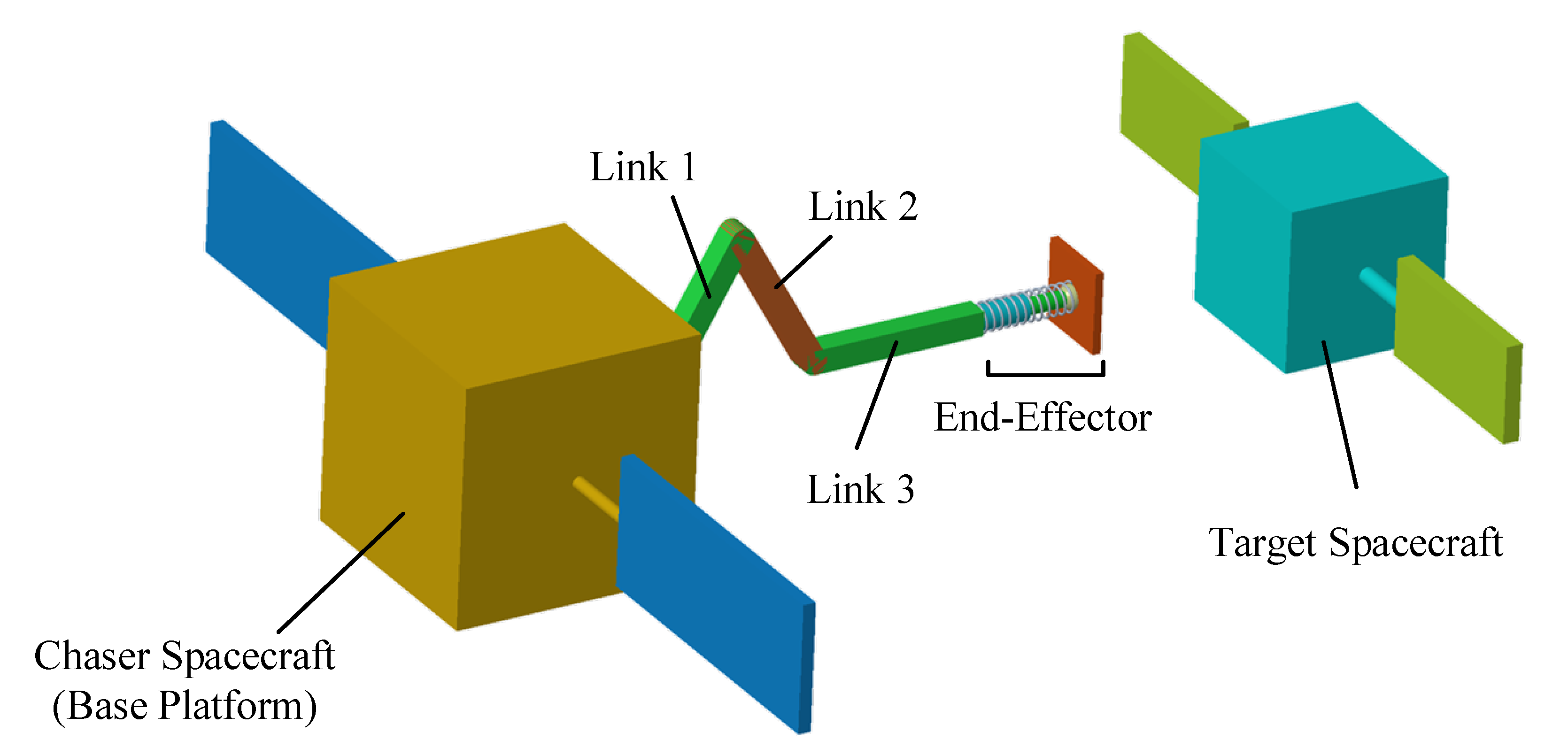
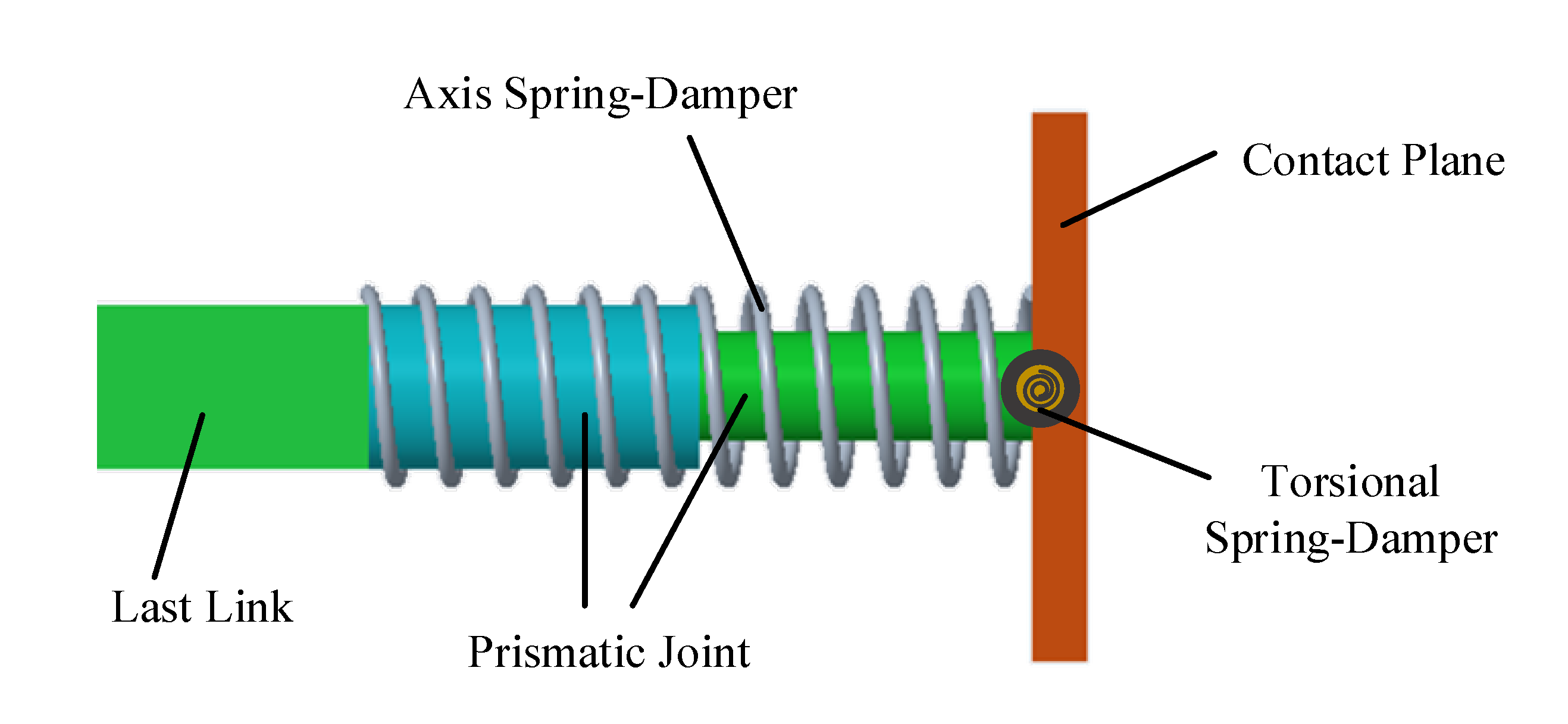



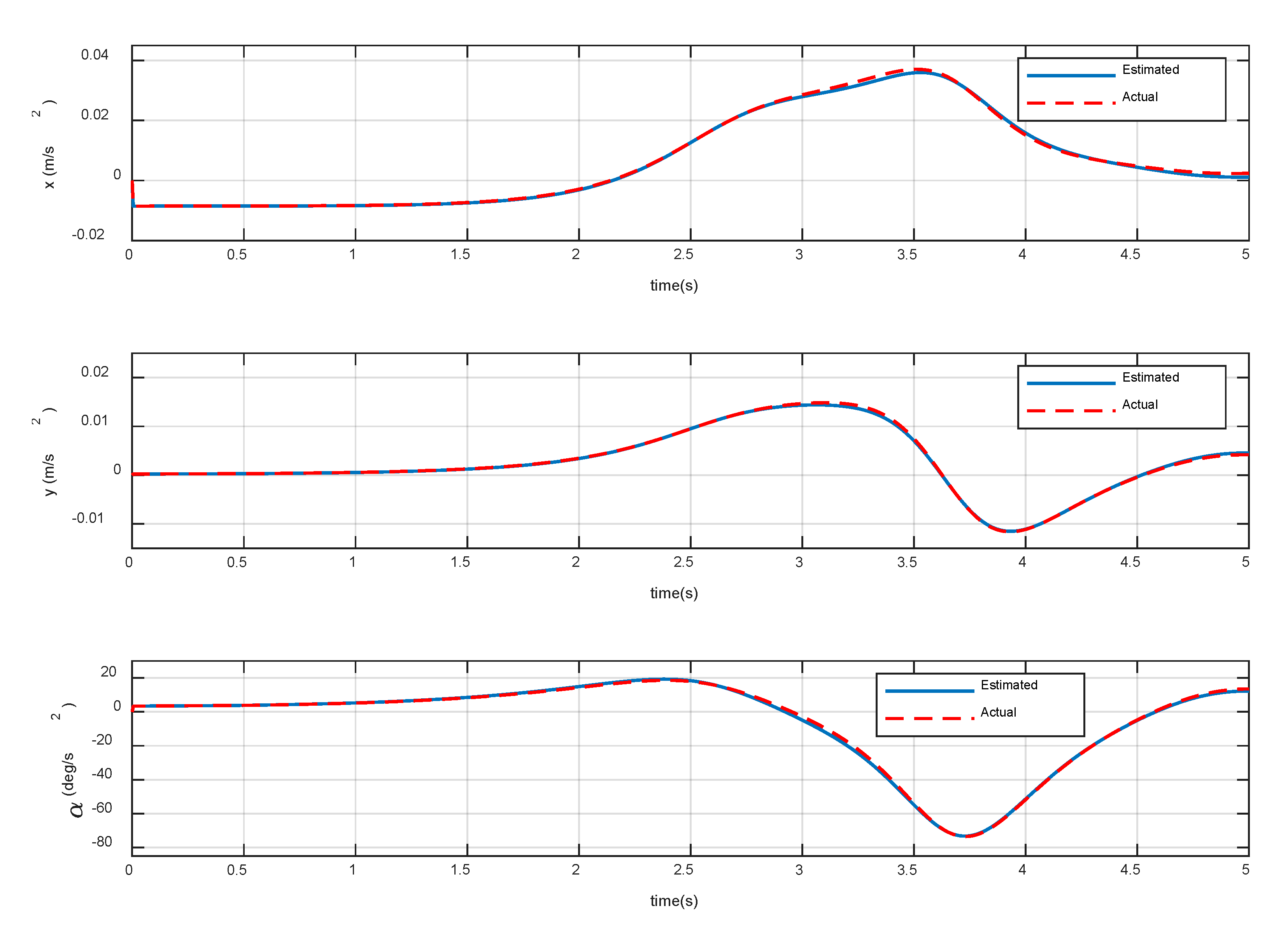
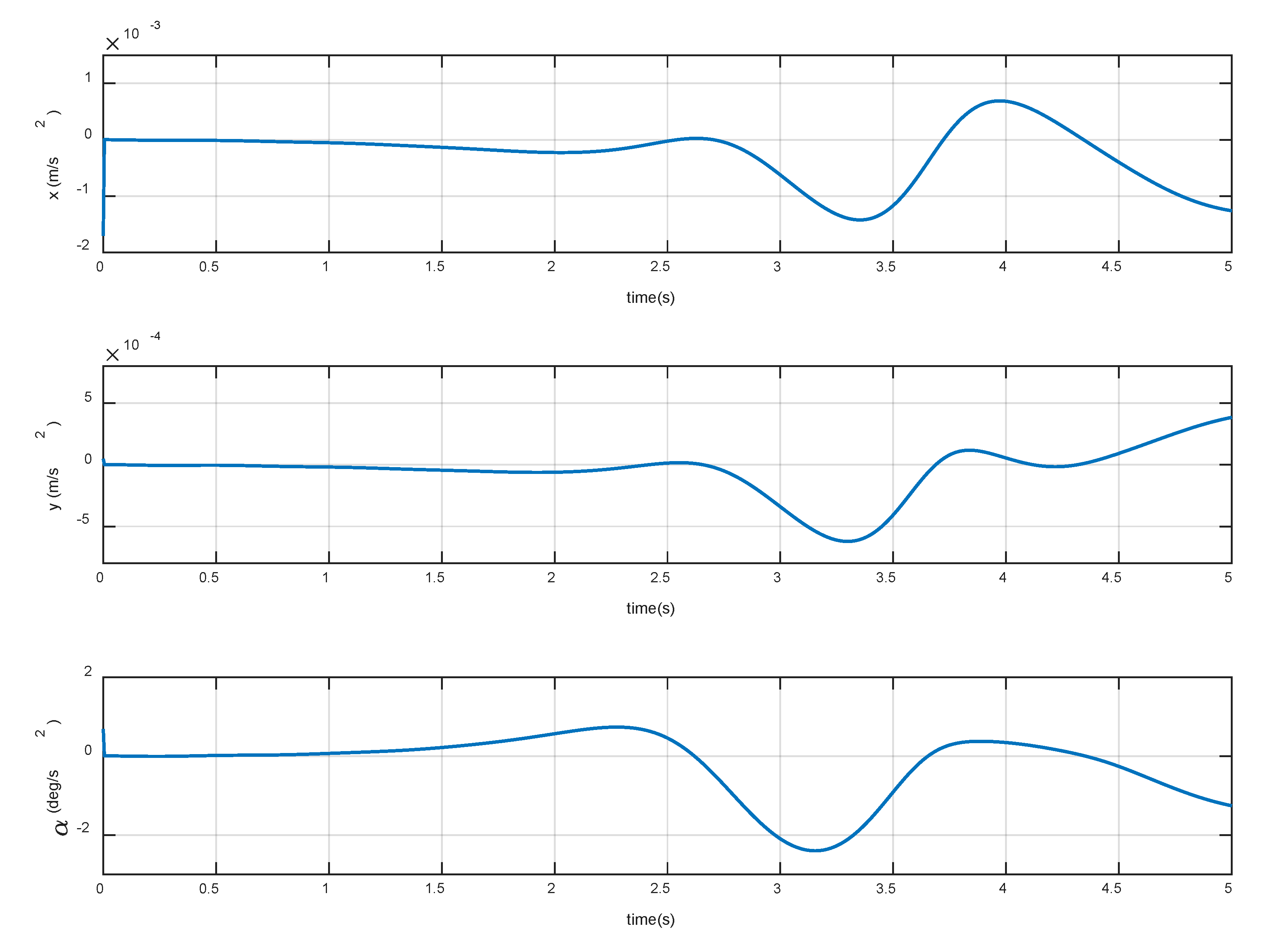




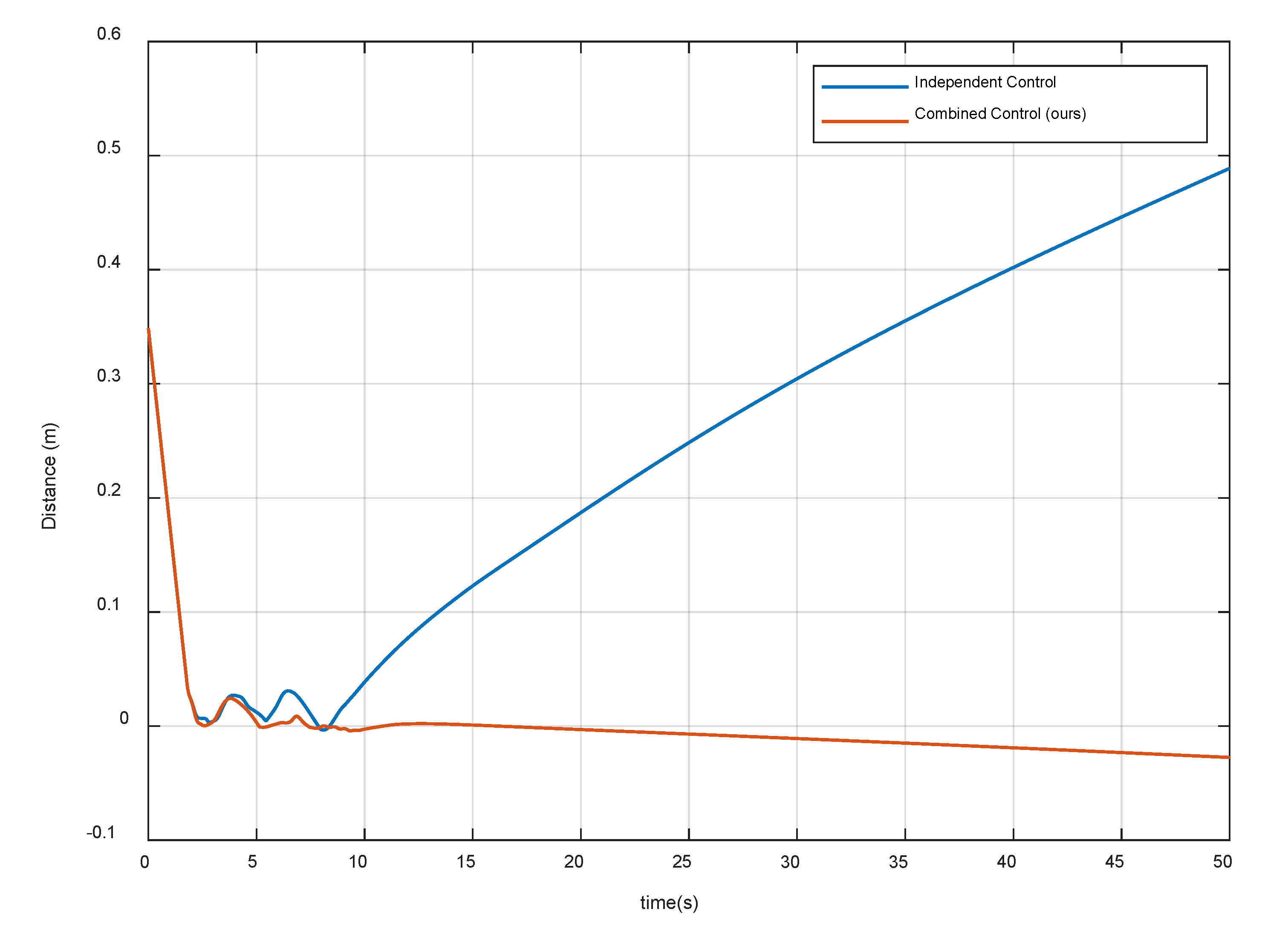
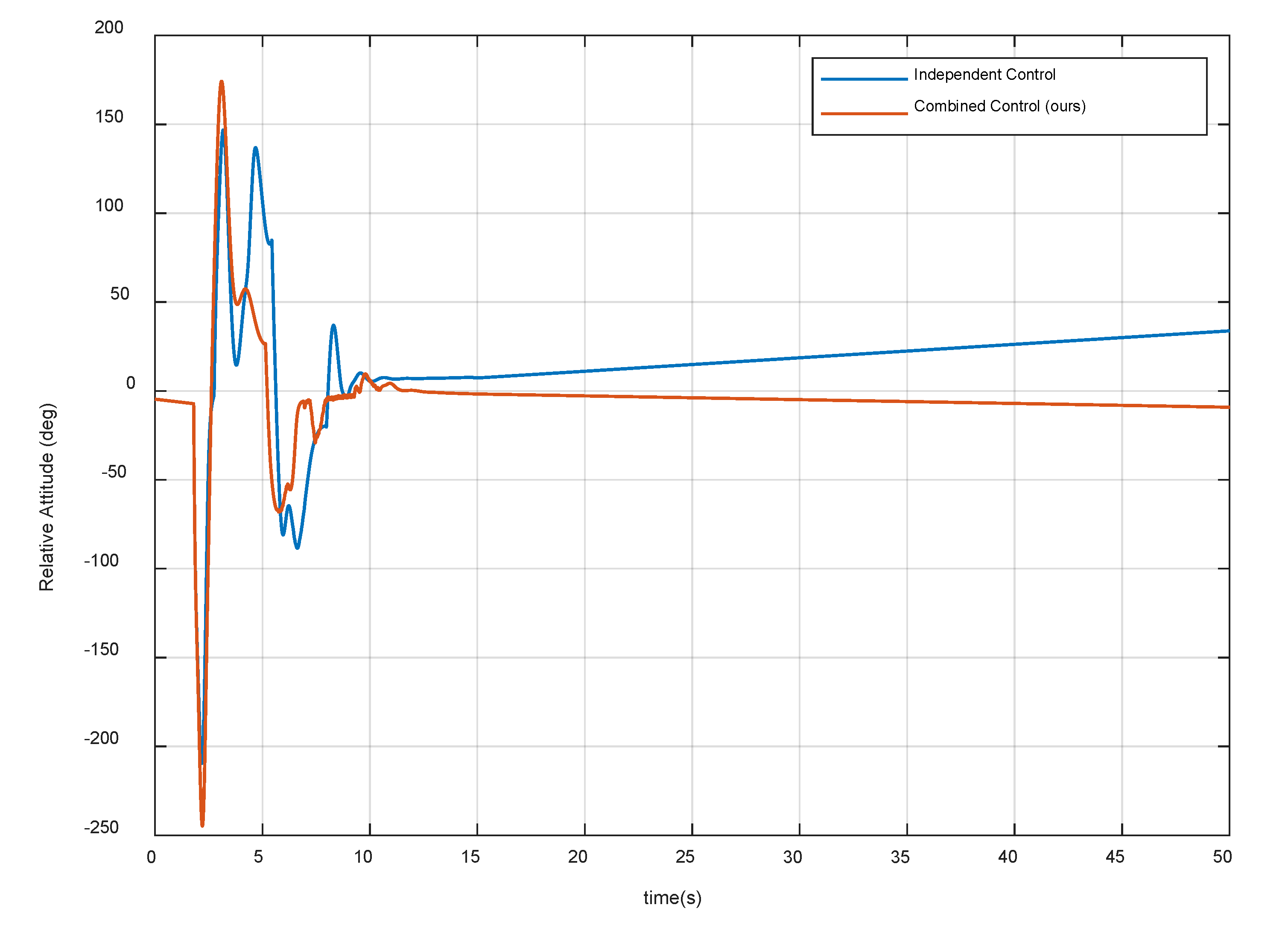
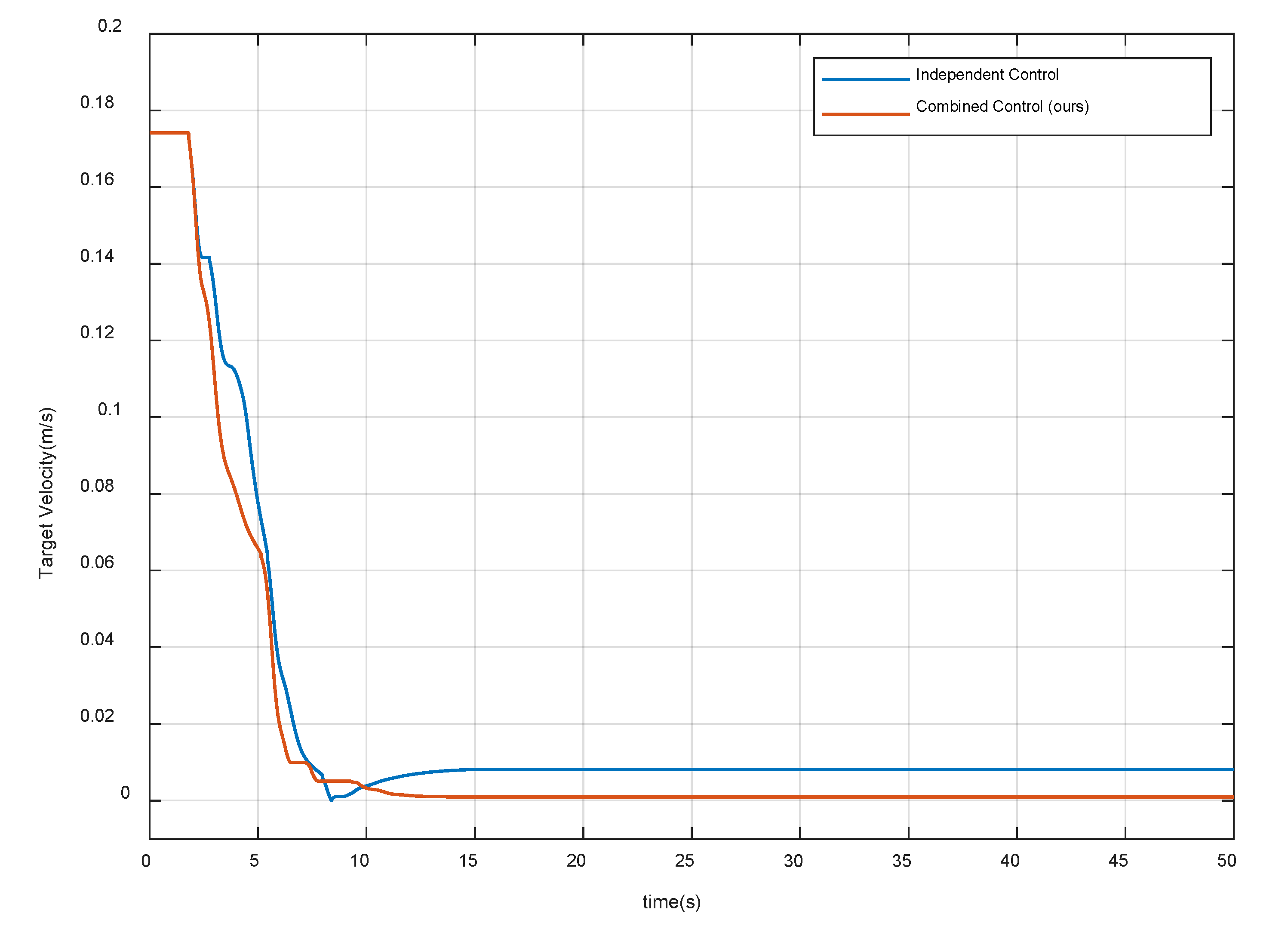
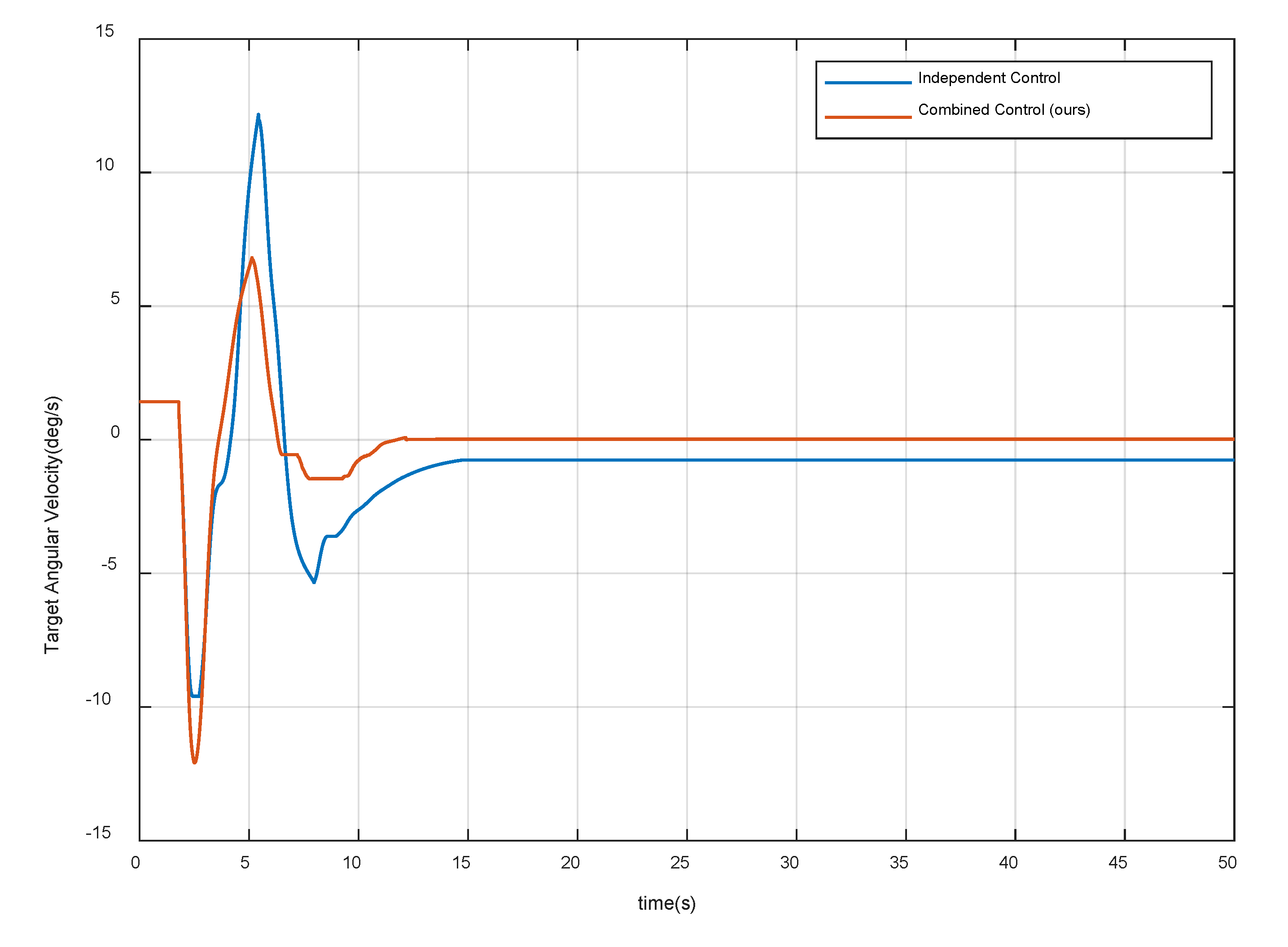
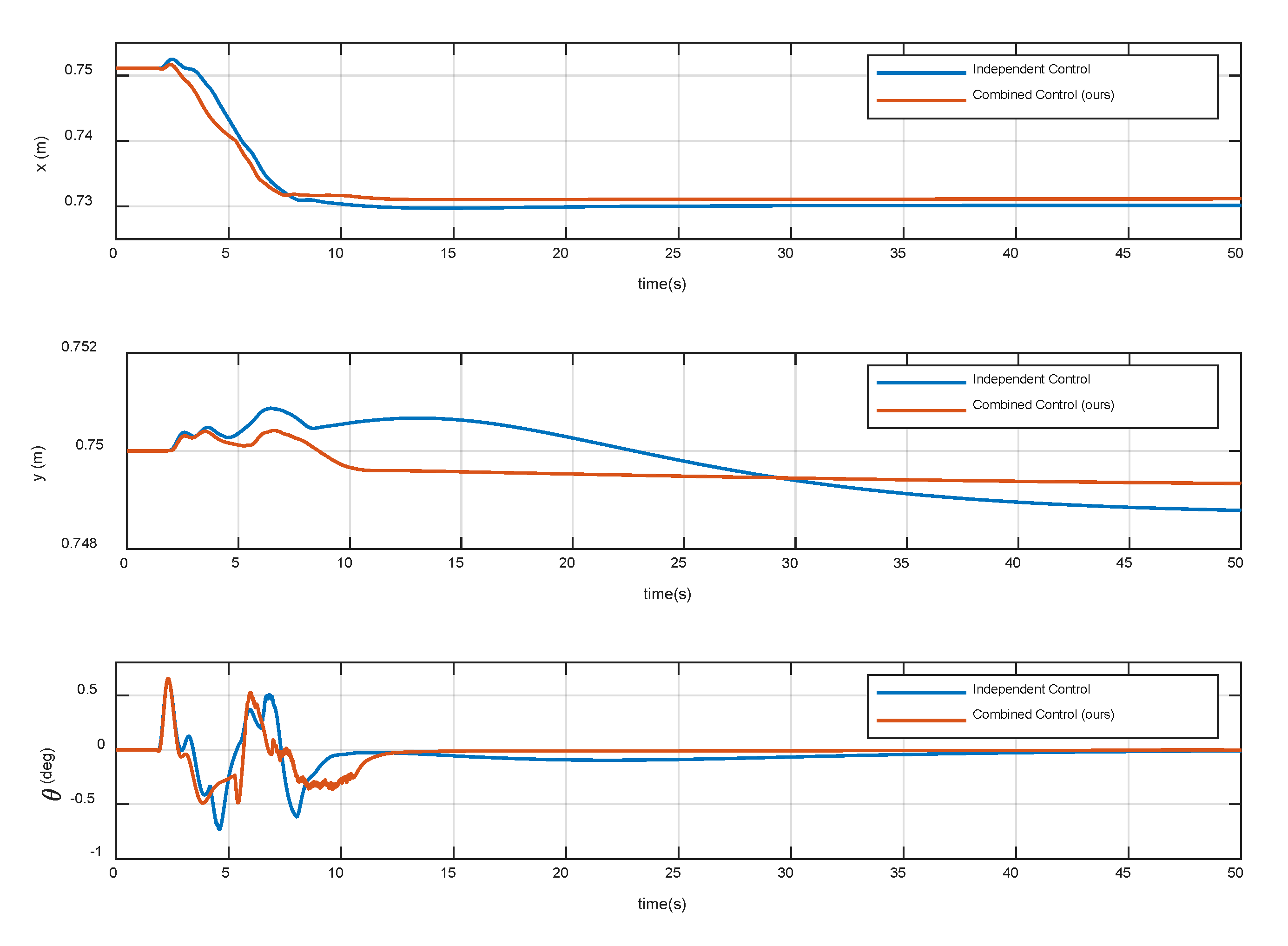


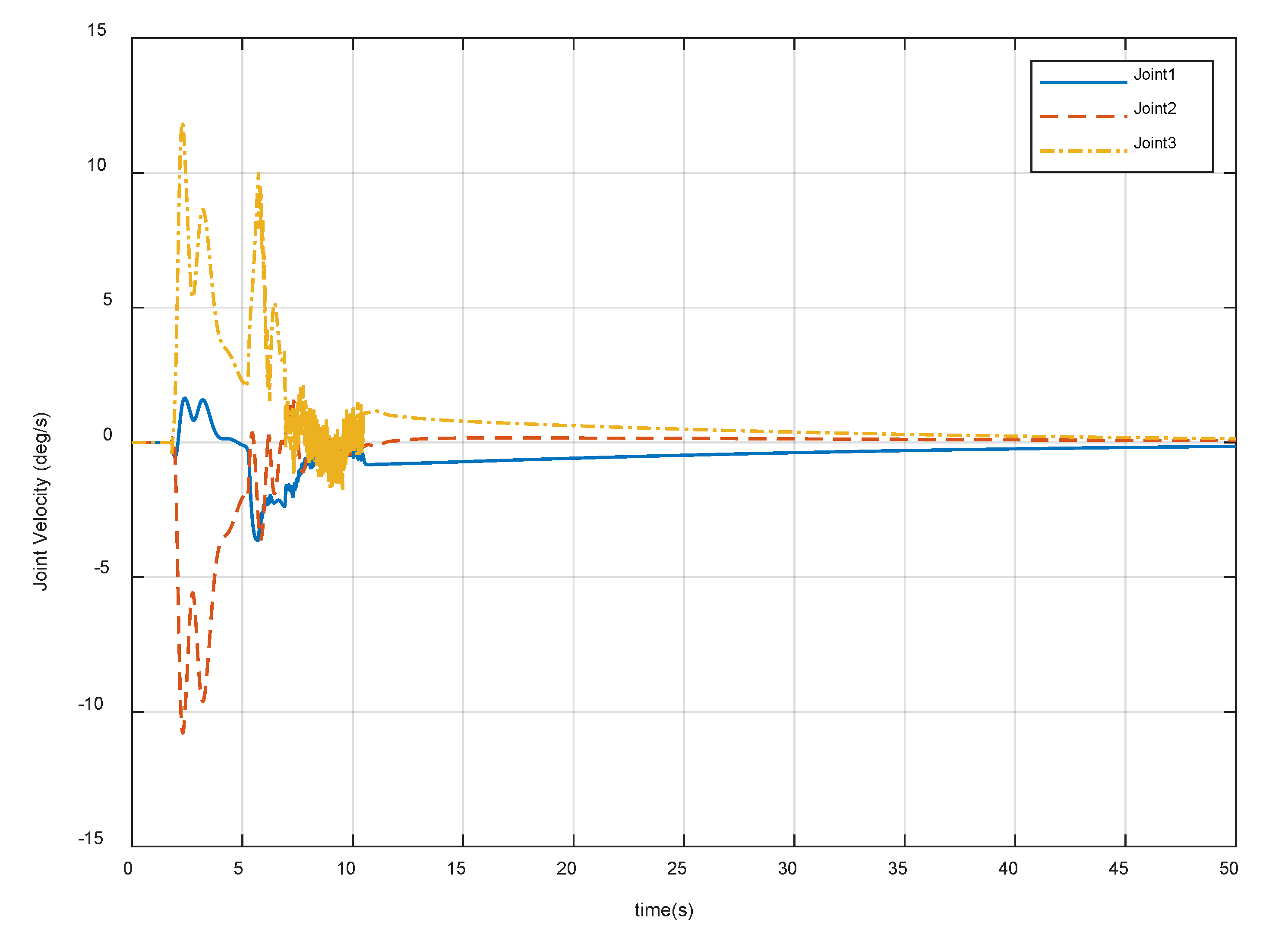

| Part | Mass (kg) | Length (m) | Moment of Inertia (kg·m2) |
|---|---|---|---|
| Base | 364.07 | 0.9 | diag (16.58, 15.57, 6.29) |
| Link 1 | 17.10 | 1 | diag (4.33 × 10−2, 1.52, 1.52) |
| Link 2 | 17.10 | 1 | diag (4.33 × 10−2, 1.52, 1.52) |
| Link 3 | 17.35 | 1.075 | diag (4.47 × 10−2, 1.59, 1.59) |
| Prismatic Joint (Part 1) | 0.88 | 0.3 | diag (1.58 × 10−3, 5.42 × 10−3, 5.42 × 10−3) |
| Prismatic Joint (Part 2) | 0.71 | 0.3 | diag (5.83 × 10−4, 3.74 × 10−3, 3.74 × 10−3) |
| Contact Plane | 3.75 | 0.05 | diag (6.89 × 10−2, 0.1062, 6.89 × 10−2) |
Publisher’s Note: MDPI stays neutral with regard to jurisdictional claims in published maps and institutional affiliations. |
© 2020 by the authors. Licensee MDPI, Basel, Switzerland. This article is an open access article distributed under the terms and conditions of the Creative Commons Attribution (CC BY) license (http://creativecommons.org/licenses/by/4.0/).
Share and Cite
Kang, G.; Zhang, Q.; Wu, J.; Zhang, H. PD-Impedance Combined Control Strategy for Capture Operations Using a 3-DOF Space Manipulator with a Compliant End-Effector. Sensors 2020, 20, 6739. https://doi.org/10.3390/s20236739
Kang G, Zhang Q, Wu J, Zhang H. PD-Impedance Combined Control Strategy for Capture Operations Using a 3-DOF Space Manipulator with a Compliant End-Effector. Sensors. 2020; 20(23):6739. https://doi.org/10.3390/s20236739
Chicago/Turabian StyleKang, Guohua, Qi Zhang, Jiaqi Wu, and Han Zhang. 2020. "PD-Impedance Combined Control Strategy for Capture Operations Using a 3-DOF Space Manipulator with a Compliant End-Effector" Sensors 20, no. 23: 6739. https://doi.org/10.3390/s20236739
APA StyleKang, G., Zhang, Q., Wu, J., & Zhang, H. (2020). PD-Impedance Combined Control Strategy for Capture Operations Using a 3-DOF Space Manipulator with a Compliant End-Effector. Sensors, 20(23), 6739. https://doi.org/10.3390/s20236739





